 Definition of Incapacity Policy v10.0
Summary
b
Definition of Incapacity Policy v10.0
Summary
b 'Incapacity' for these clients is determined by whether the
personal injury restricts or prevents them, mentally or
physically, from being able to perform their employment
Objective
activities.
This page provides you with the definition of ‘incapacity’ pro-
vided by the Accident Compensation Act 2001. A client's eligi-
c To determine whether a client is unable to work due to
bility for weekly compensation depends on their inability to carry
the injury, refer to Determine incapacity - client employed
out employment.
at the time of injury.
Determine incapacity – client employed at the time of
Use this guidance to determine incapacity of a client, ie whether
injury (CHIPS)
the client is unable, because of their personal injury, to engage
in either:
• employment that they were in when they suffered the personal
3.0 Determine incapacity under Section 105 of the
injury (section 103)
• work that they are suited for based on their experience, edu-
Accident Compensation Act 2001
cation, training, or combination of those things (section 105).
a Section 105 of the Accident Compensation Act 2001 ap-
plies if, when the client became unable to work, they:
If a client is not incapacitated, then a client is not eligible for
• were a potential earner
weekly compensation.
• had a TimeOut cover policy
• were not in employment, but had recently ceased
This guidance applies to incapacities that occurred from 1 July
employment and extension of employee status applies.
2010.
b 'Incapacity' for these clients is determined by whether the
1) Definition of incapacity
personal injury restricts or prevents them, mentally or
2) Determine incapacity under Section 103 of the Accident
physically, from being able to engage in employment for
Compensation Act 2001
which they are suited by reason of education, experience
3) Determine incapacity under Section 105 of the Accident
or training, or a combination of these things.
Compensation Act 2001
c To determine whether the client is unable to work due to
4) Links to legislation
the injury, and what is suitable employment, refer to
Determine incapacity – client has ceased employment,
Owner
9(2)(a)
was potential earner or has TimeOut cover.
Expert
9(2)(a)
Determine incapacity – client has ceased employ-
ment, was potential earner or has TimeOut cover
Policy
(CHIPS)
1.0 Definition of incapacity
a Section 6 of the Accident Compensation Act 2001 defines
4.0 Links to legislation
‘incapacity’ as determined under either:
Accident Compensation Act 2001, section 103
• Section 103 or
http://www.legislation.govt.nz/act/public/2001/0049/
• Section 105.
latest/DLM101458.html
Sections 103 and 105 of the Accident Compensation Act
Accident Compensation Act 2001, section 105
2001 only apply to the covered personal injury.
http://www.legislation.govt.nz/act/public/2001/0049/
NOTE Accident Compensation Act 2001, section
latest/DLM101462.html
103
The client is unable to engage in employment for
which they were employed when the personal
injury was suffered.
NOTE Accident Compensation Act 2001, section
105
The client is unable to engage in employment for
which they are suited by reason of education,
experience or training, or a combination of these
things.
b Inability to work includes being absent from employment
to get treatment for the personal injury if the treatment is:
• necessary for the injury
• of a type that we, as the insurer, are liable to provide.
2.0 Determine incapacity under Section 103 of the
Accident Compensation Act 2001
a Section 103 of the Accident Compensation Act 2001 ap-
plies if, at the time of the injury, the client is:
• an earner
• on unpaid parental leave or
• a recuperating organ donor.
ACC > Claims Management > Manage Client Payments > Operational Policies > Weekly Compensation > Incapacity > Definition of Incapacity Policy
Uncontrolled Copy Only : Version 10.0 : Last Edited Wednesday, January 29, 2020 2:29 PM : Printed Monday, October 5, 2020 8:07 AM
Page 1 of 1
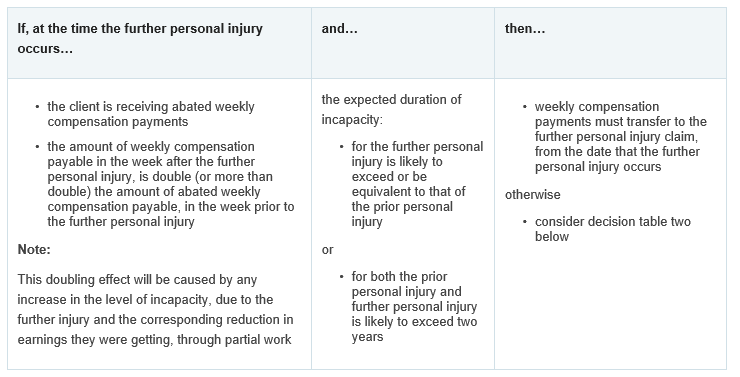
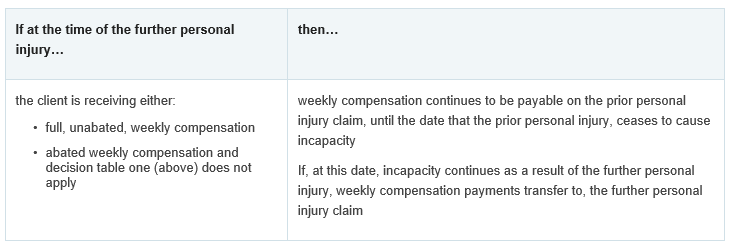
 Further Personal Injury v12.0
Summary
3.0 If and when to transfer costs
a
Further Personal Injury v12.0
Summary
3.0 If and when to transfer costs
a In cases of further personal injury, a decision needs to be
Objective
made about whether, weekly compensation should be
Refer to this guidance when a client suffers a further per-
paid on the further personal injury claim, and if so, from
sonal injury. This information applies to claims where the client
when.
became unable to work from 1 July 2010.
Use the attached two decision tables to determine if and
1) Rules
when to transfer costs, from the prior personal injury
2) Exceptions
claim, to the further personal injury claim.
3) If and when to transfer costs
4) Transferring weekly compensation
b Decision table one - abated weekly compensation
5) Further personal injury is fatal
6) Letter to treatment provider
7) Confirming eligibility for new injury
8) Self-employed people and non-PAYE shareholder employees
Owner
9(2)(a)
Expert
9(2)(a)
Procedure
1.0 Rules
a
Decision table one - abated weekly
A client who is unable to work due to a personal injury
compensation.PNG
and receiving weekly compensation from ACC may sus-
tain a further personal injury, which is also covered by
NOTE Example
ACC.
A client injures their right knee while at work,
which causes a permanent inability to perform
For example, a client may be on weekly compensation
their work duties. ACC determines that they are
for a knee injury sustained while playing sport then, also
eligible to receive a weekly compensation pay-
suffer a back injury lifting a heavy object in a separate
ment of $400 per week.
accident. This second injury is regarded as a further per-
sonal injury.
The client gradually returns to a new job at near
full capacity and is receiving $100 abated weekly
In such cases, ACC needs to decide if and when weekly
compensation per week when they have a motor
compensation payments should be transferred, from the
vehicle accident and injure their left leg, which
prior personal injury claim, to the further personal injury
results in an amputation. Weekly compensation
claim. This is because a client cannot receive weekly
payable after the further personal injury is $400,
compensation on more than one claim file at a time.
because the client is certified fully unfit for work
from the date that the further personal injury
If there is a transfer, the existing weekly earnings calcu-
occurs.
lation on the prior personal injury claim, continues to
apply on the further personal injury claim. A recalculation
As weekly compensation payable in the week
of weekly earnings, based on earnings prior to the date of
following the further personal injury (that is,
the further personal injury, is not required.
$400) is more than double the amount payable in
the week prior to the further personal injury (that
is, $100), and medical evidence confirms that
2.0 Exceptions
both the first and second injury are likely to
a
cause inability to work of equivalent duration,
There are two exceptions when considering whether to
weekly compensation is transferred to the further
transfer costs from the prior personal injury claim, to the
personal injury claim from the date that this fur-
further personal injury claim:
ther personal injury occurs.
1) If Earnings Related Compensation (ERC) was being
c Decision table two
paid on two claim files immediately before 1 July 1992
and these payments were carried over under the transi-
tional provisions, of the Accident Rehabilitation and
Compensation Insurance Act 1992 and subsequently car-
ried forward under the transitional provision, of the Acci-
dent Insurance Act 1998 and the Accident Compensation
Act 2001
2) If a client is receiving compensation as a dependent,
Decision table two.PNG
on an accidental death claim and is also receiving weekly
compensation for loss of earnings, due to personal injury
on another claim.
ACC > Claims Management > Manage Client Payments > Operational Policies > Weekly Compensation > Incapacity > Further Personal Injury
Uncontrolled Copy Only : Version 12.0 : Last Edited Tuesday, July 21, 2020 11:39 AM : Printed Monday, October 5, 2020 8:17 AM
Page 1 of 3
4.0 Transferring weekly compensation
6.0 Letter to treatment provider
a Under the Accident Compensation Act 2001, Schedule 1
a If a letter to the client’s treatment provider is required to
Clause 48 a client’s eligibility for weekly compensation for
establish the date on which the inability to work, due to
the further personal injury is based on the client’s weekly
the initial personal injury, will cease and the date on
earnings from the prior personal injury claim.
which the inability to work, due to the further personal
injury, will cease, the following questions may be helpful:
This means that the weekly earnings, as calculated on
the prior personal injury claim, updated for any applicable
• In your opinion, on what date would <client’s name>
indexation, become the weekly earnings for the further
have been fit for work, after their initial personal injury?
personal injury claim.
• If you are unable to provide this date, is it your view that
Similarly, as the client’s inability to work is continuous be-
the inability to work, due to <client’s name> initial per-
tween the prior personal injury claim and the further per-
sonal injury, will continue beyond that, due to their further
sonal injury claim, the inability to work regime of the prior
(new) personal injury?
personal injury claim is carried forward to the further per-
sonal injury claim. That is, the same first week, short-term
• Is <client’s name> further personal injury contributing to
and long-term periods that applied on the prior personal
their current inability to work?
injury claim will also apply on the further personal injury
claim. In other words the second claim ’picks up‘ the
• Has <client’s name> further personal injury delayed
regime of inability to work, of the prior personal injury
recovery from their initial personal injury?
claim.
• Is it your view that <client’s name> inability to work, due
See: Examples: Transferring weekly compensation - Ref-
to their initial personal injury, would have stopped, before
erence
the inability to work due to their further personal injury
stopped? That is, would they have received a clearance,
NOTE If the further personal injury is a work injury
had it not been for their further personal injury?
and the employer has made a first week pay-
ment then those earnings will need to be
• In your opinion, on what date should <client’s name>
considered for abatement.
inability to work, due to their further personal injury stop?
Examples – transferring weekly compensation - Ref-
• For what period will <client’s name> be unable to work,
erence
solely as a result of their further personal injury?
http://thesauce/team-spaces/chips/compensation/
weekly-compensation/reference/incapacity-187/
• If you are unable to advise on any of these points,
examples--transferring-weekly-compensation/
would you please give the reason, or a date when this
index.htm
information will be available.
Accident Compensation Act 2001, Schedule 1,
NOTE Wherever possible in these questions, subs-
Clause 48
titute a brief description of the relevant injury
http://www.legislation.govt.nz/act/public/2001/0049/
for the terms ’initial personal injury‘, and ’fur-
latest/DLM104893.html
ther personal injury’. Take care not to request
information that ACC already has.
5.0 Further personal injury is fatal
a If the further personal injury results in death, inability to
7.0 Confirming eligibility for new injury
work on the prior personal injury claim ceases at the date
of death.
a If a person suffers a new injury, that makes them unable
to work within 28 days of ceasing weekly compensation
Weekly compensation ceases to be payable on the prior
on a prior personal injury claim, confirm whether the
personal injury claim at the date of death. If the fatal
client is eligible for weekly compensation for the new
claim is accepted, payment of weekly compensation
injury.
based on the prior claims weekly earnings is payable to
spouses, children and other dependants of the deceased
That is, they are an earner in employment at the time the
from the date of death.
new injury occurred and have earnings immediately
before they became unable to work due to the new injury.
See: Determine when to transfer weekly compensation to
See: Determine employment type and eligibility
the further personal injury claim
Where a new inability to work applies, weekly earnings
Determine when to transfer weekly compensation to
are always recalculated based on earnings before the
the further personal injury claim - Reference
client became unable to work for the new injury.
http://thesauce/team-spaces/chips/compensation/
weekly-compensation/reference/incapacity-187/
Deciding employment type and eligibility - Reference
transfer-weekly-compensation-to-the-further-injury-
http://thesauce/team-spaces/chips/compensation/
claim/index.htm
weekly-compensation/reference/eligibility-187/
deciding-employment-type-and-eligibility/index.htm
ACC > Claims Management > Manage Client Payments > Operational Policies > Weekly Compensation > Incapacity > Further Personal Injury
Uncontrolled Copy Only : Version 12.0 : Last Edited Tuesday, July 21, 2020 11:39 AM : Printed Monday, October 5, 2020 8:17 AM
Page 2 of 3
 8.0 Self-employed people and non-PAYE share-
holder employees
8.0 Self-employed people and non-PAYE share-
holder employees
Further personal injury Policy.PNG
Gather information for self-employed Policy
https://go.promapp.com/accnz/Process/20a673e5-
f5ed-456a-acee-5f58c78f6d09
Gather information for shareholder employees Policy
https://go.promapp.com/accnz/Process/a965edac-
ca71-4d31-85d2-81688bb1cfc7
Calculate weekly compensation Policy
https://go.promapp.com/accnz/
Process/69479386-2eb5-4624-b1d8-1ec9c4f4354f
9.0 How to request a further injury transfer of
entitlement
a Determine information required by the Payments Team
NOTE What information does the payments team re-
quire?
You need to complete a Non-Standard Eform (or
all of the requisite information provided in the
task) and provide:
- The originating claim number
- The further injury transfer date
- Approved incapacity from the date of entitle-
ment on the further injury claim
- Any other instructions that may be relevant for
the assessment
You also need to:
- Wind back medical cover to the day before the
further injury transfer date on the originating
claim. (Consider changing this date if the action
will result in an overpayment to the client)
Add an Eform
http://thesauce/team-spaces/eos-online-help/
documents/add-an-eform/index.htm
Add approved incapacity
Modify approved incapacity
b Create task for payments team and link required infor-
mation
NOTE What task should I use to make the request
Use the Setup Weekly Compensation Task and
link the completed Non-Standard E-Form to the
task
Link a document to a task in Eos
PROCESS
Transfer Weekly Compensation to a
New Claim due to Further Injury
ACC > Claims Management > Manage Client Payments > Operational Policies > Weekly Compensation > Incapacity > Further Personal Injury
Uncontrolled Copy Only : Version 12.0 : Last Edited Tuesday, July 21, 2020 11:39 AM : Printed Monday, October 5, 2020 8:17 AM
Page 3 of 3
 Straight-Through Payment Processing Business Rules v2.0
Summary
Objective
Straight-Through Payment Processing Business Rules v2.0
Summary
Objective
This page lists the business rules related to straight-through
payment processing.
Owner
9(2)(a)
Expert
9(2)(a)
Policy
1.0 Straight-through payment processing business
rules
a Business rules governing straight-through processing of
electronic ACC18s.
Automatic approval of a pending activity period
Definition of a pending activity period
Automatic approval of a weekly compensation pay-
ment for a payable activity period
Notification for a manual approval of and activity
period payment
Definition of a non-payable activity period
Definition of a payable activity period
Definition of a valid IRD Number
Pending activity periods for an exception payment
may be automatically approved
Payments for an exception payment may be
automatically approved
ACC > Claims Management > Manage Client Payments > Operational Policies > Weekly Compensation > Incapacity > Straight-Through Payment Processing Business Rules
Uncontrolled Copy Only : Version 2.0 : Last Edited Friday, May 17, 2019 3:32 AM : Printed Sunday, October 4, 2020 8:12 PM
Page 1 of 1
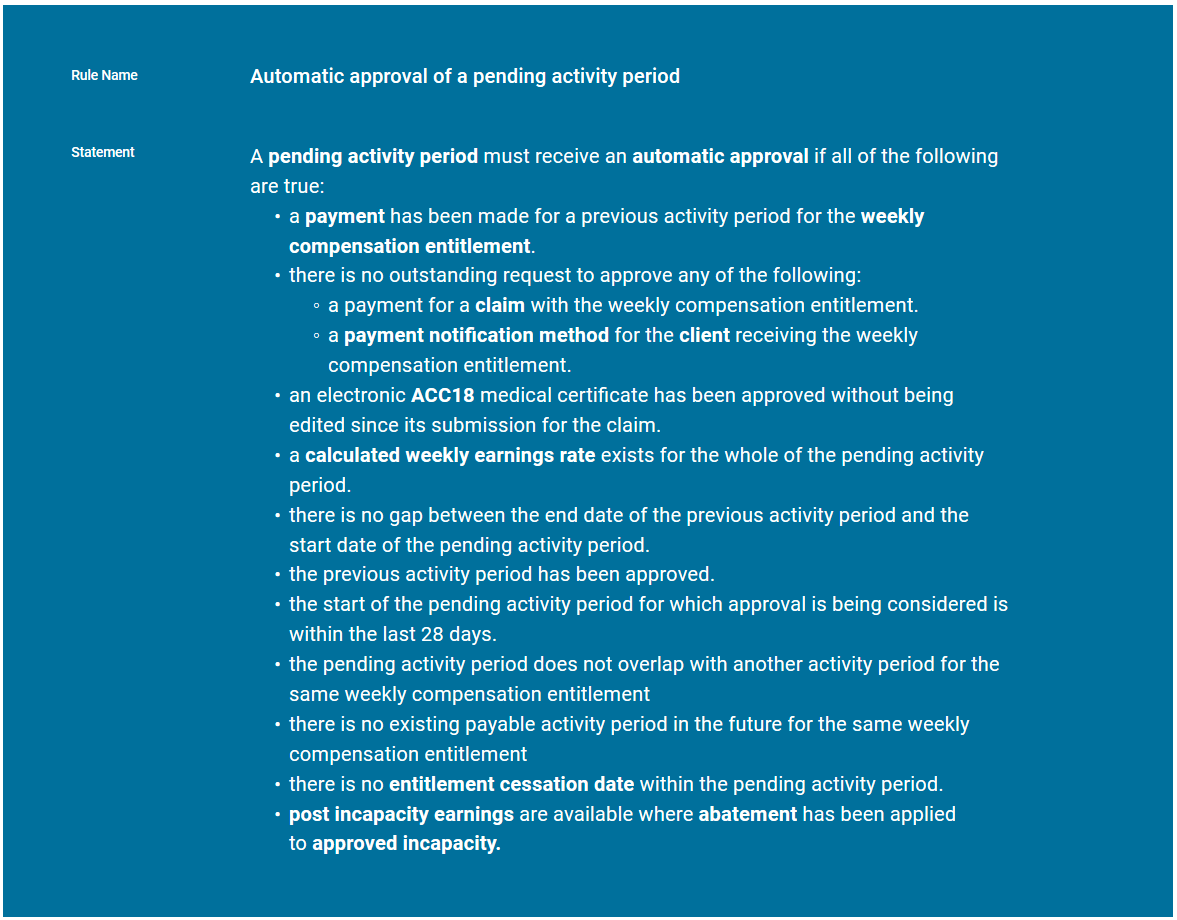

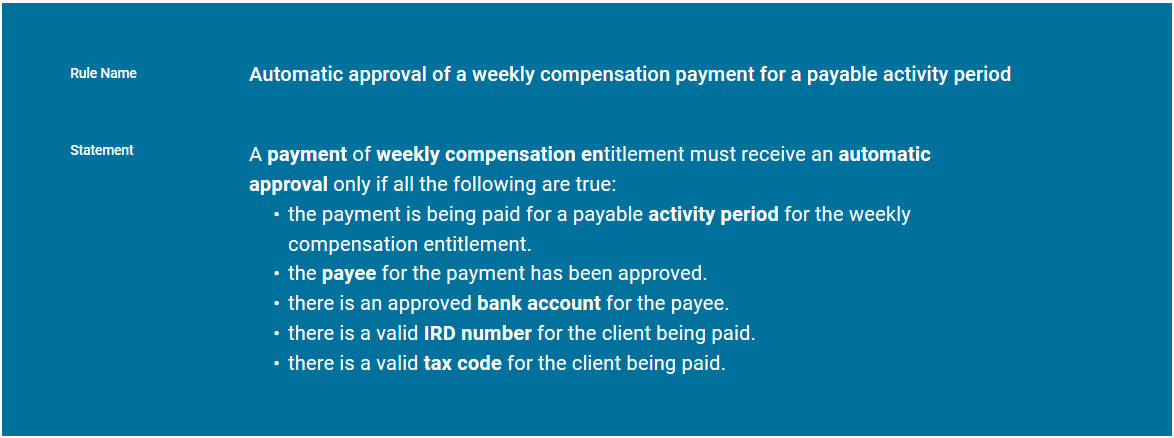 Straight-Through Payment Processing Business Rules
Straight-Through Payment Processing Business Rules






 Establishing Date of First Incapacity (DOFI) v8.0
Summary
4.0 Client on leave
Objective
a
Establishing Date of First Incapacity (DOFI) v8.0
Summary
4.0 Client on leave
Objective
a If a client is on annual or other paid leave on the first day
Determining the date of first incapacity (DOFI) is important as it
they are certified as unfit for work, this day is DOFI. This
establishes when a client’s first week period starts. Refer to this
is regardless of whether or not the business was open at
guidance to help you determine the first week period and estab-
the time the client was on annual, or other paid leave.
lish the start of the client’s weekly compensation.
b Determine DOFI as if they had not been on leave at the
time.
1) Determining a client’s DOFI
2) Time off work for treatment before certified as unable to work
c For example: A worker who normally works on Mondays:
3) No time off work for treatment before certified as unable to
• is on leave on a Monday, when they suffer an injury
work
• is certified as being unable to work from that day.
4) Client on leave
The Monday date is the DOFI date.
5) Statutory holidays
d This also applies if the client is on unpaid leave when in-
jured, provided they are accepted as being an earner.
Owner
See Unpaid leave.
9(2)(a)
Unpaid leave
Expert
9(2)(a)
https://go.promapp.com/accnz/
Process/6b0e3eaa-4d40-41a7-bbb7-084a7fb81470
Policy
1.0 Rules
5.0 Statutory holidays
a A client’s date of first incapacity (DOFI) is the earlier of
the first date that they:
a DOFI is the first date the client was medically certified as
• were medically certified as unfit for work due to their
unable to work.
injury
b If a statutory holiday falls between the date that the client
• had time off work to receive necessary health care
is certified as being unable to work and the day that they
treatment for their injury.
would have worked, if not for being unable to work due to
b Each claim can have only one DOFI date.
the injury, DOFI is taken as the earlier date, ie the date
they were certified as unable to work.
c If the client has an injury, they will be medically certified
as unfit for their employment from the date they were first
off work due to this personal injury. This date is the DOFI.
Definition of incapacity
https://go.promapp.com/accnz/Process/4a00b447-
a198-4dee-9537-facfa9ff9376
Examples – determining DOFI - Reference
http://thesauce/team-spaces/chips/compensation/
weekly-compensation/reference/incapacity-187/
examples--determining-dofi/index.htm
2.0 Time off work for treatment before certified as
unable to work
a If the client has taken time off work for treatment before
the date they were first medically certified as unable to
work, the date of that treatment is DOFI.
b This earlier date can only be used as DOFI if ACC is re-
quired, or allowed, to pay for the type of treatment they
received.
c ACC also needs confirmation from the employer of any
actual time taken off work.
3.0 No time off work for treatment before certified
unable to work
a If the client has not had time off during work hours for
necessary treatment, DOFI is the first date they were
medically certified as unable to work.
b For example: a Monday to Friday worker:
• suffered an injury after work on Friday
• went to the doctor the next day, where they were cer-
tified unable to work from that day.
The Saturday's date is the DOFI.
ACC > Claims Management > Manage Client Payments > Operational Policies > Weekly Compensation > Incapacity > Establishing Date of First Incapacity (DOFI)
Uncontrolled Copy Only : Version 8.0 : Last Edited Wednesday, January 29, 2020 2:26 PM : Printed Monday, October 5, 2020 8:16 AM
Page 1 of 1
 Medical Certification for Non-Serious Injury Claims v12.0
Summary
4.0 Criteria
Objective
a
Medical Certification for Non-Serious Injury Claims v12.0
Summary
4.0 Criteria
Objective
a Medical certificates can be accepted for periods ex-
This entry informs you about the ways we accept medical certif-
ceeding 13 weeks, for a maximum period of 12 months, if
icates, the frequency that the client must provides us with a
all the following are met:
medical certificate. Refer to this guidance to determine whether
• physical or mental restrictions have stabilised and are
a client is exempt from submitting a medical certificate every 13
likely to remain unchanged
weeks, and whether we can pay them if there are gaps between
• these restrictions mean the client is unable to perform
medical certificates.
any work
• eligibility for long-term support is not in doubt.
1) Frequency of medical certificates
b Significant periods of backdated support, if maintained by
2) Acceptance of certificates
medical evidence, eg an Occupational Physician’s report.
3) Exemptions
4) Criteria
5) Rules
6) Cases where an exemption should not apply
5.0 Rules
7) Unstable health status: Serious Injury clients
a Agreement to less frequent medical certificates must be
8) Monitoring exemptions
documented in the client’s Individual Rehabilitation Plan
9) Gaps of time between medical certificates
(IRP).
10) Gaps between medical certificates of less than 29 days
b The client must agree that:
11) When the gap between medical certificates is longer than 28
• the case manager will monitor their ongoing inability to
days, or 90 in the case of a seriously injured client
work as part of scheduled, regular contact
12) Compensation for permanent inability to work
• the client, or their representative, must regularly com-
plete a personal declaration, stating they are aware of
Background
their responsibility to declare to ACC, any change in work
To be eligible for ongoing weekly compensation, clients must
fitness and other income, to continue being eligible for
provide ACC with regular medical certificates certifying their ina-
weekly compensation.
bility to work.
NOTE This declaration is necessary to monitor
progress and reduce the potential for fraud.
Regular medical certificates allow ACC to monitor a client’s con-
tinued need for weekly compensation and rehabilitation.
Owner
9(2)(a)
6.0 Where the exemption to allow less frequent
Expert
9(2)(a)
medical certificates does not apply
Policy
a The exemption to allow less frequent medical certificates
should not apply in the following cases:
1.0 Frequency of medical certificates
• strain and sprain cases, including back strains and
occupational overuse claims
a ACC requires medical certificates to be submitted at least
• serious injury – where the client is ‘non-compliant’ with
every 13 weeks, for long-term clients.
treatment or rehabilitation
b Where the client is receiving on-going treatment from a
• clients who are residing overseas
medical practitioner, more frequent certificates may be
• sensitive claims – other than when they involve serious
appropriate to ensure:
injury clients who are receiving intensive treatment.
• the client attends the medical/nurse practitioner when
b Serious injury status, for a sensitive claim, is usually for a
requested
temporary duration of six months to two years while the
• the client’s condition does not change in the meantime,
client receives intensive, usually in-patient or residential,
enabling them to return to work.
treatment. In these situations the duration of a medical
certificate is determined between the case manager,
client and health provider, and is written into the client’s
2.0 Acceptance of certificates
IRP.
a Certificates that result in the granting of support may be
accepted by Fax or direct from a provider electronically.
7.0 Unstable health status: Serious Injury clients
b All medical certificates must be signed by the relevant
provider, or, in the case of an eACC18, must be appro-
a Where the health status of the client is fragile or unstable,
priately authorised by the provider. The patient does not
eg where there are pressure sores or recurrent infec-
need to sign either the ACC18 or eACC18.
tions, the exemption to allow less frequent medical certif-
icates does not apply. This includes all ventilator-
dependent tetraplegics.
3.0 Exemptions
b In these cases, although the client’s level of physical
a It may be appropriate to require medical certificates at
restriction is not in doubt, it is vital for their health status,
intervals of more than 13 weeks, for example at six- or
that there is regular medical supervision. The 13-weekly
twelve-monthly intervals.
medical certificate provides this opportunity.
b Ongoing inability to work because of their injury, is in-
stead, monitored by regular contact with the case man-
ager.
ACC > Claims Management > Manage Client Payments > Operational Policies > Weekly Compensation > Incapacity > Medical Certification for Non-Serious Injury Claims
Uncontrolled Copy Only : Version 12.0 : Last Edited Tuesday, August 18, 2020 10:54 AM : Printed Monday, October 5, 2020 8:20 AM
Page 1 of 2
8.0 Monitoring less frequent medical certificate
11.0 When the gap between medical certificates is
exemptions
longer than 28 days or 90 in the case of a se-
a There will be situations where an exemption for less fre-
riously injured client
quent medical certificates may need to be withdrawn
a A client can continue to be eligible for weekly compen-
once already approved, eg for reasons of non-
sation during a period of more than 28 days or 90 days
compliance.
respectively in circumstances where:
b Team Managers are responsible for ensuring that discre-
• the client has a significant injury and was obviously
tion for agreement to less regular medical certificates is
unable to work
exercised appropriately.
• the length of the period between medical certificates is
due to the fact, that the client was otherwise unable to
c Team Managers are also responsible for monitoring the
get to a doctor, eg this could be because of an illness.
use of this discretion as part of their coaching and Quality
Assurance responsibilities.
Request an exemption - Reference
12.0 Permanent eligibility for weekly compensation
http://thesauce/team-spaces/chips/compensation/
a Clients who, prior to 1 October 1992, were formally as-
weekly-compensation/reference/incapacity-187/
sessed for and awarded compensation for permanent
request-an-exemption/index.htm
eligilbility for weekly compensation under Accident
Entering details into Eos Contacts - Reference
Compensation Act 1972, Section 114 or Accident
http://thesauce/team-spaces/chips/compensation/
Compensation Act 1982, Section 60 are not required to
weekly-compensation/reference/incapacity-187/
provide ACC with medical certificates.
entering-details-into-eos-contacts/index.htm
b Any case involving a client who is not eligible for a per-
manent inability to work award, as outlined above and
who is not providing regular medical certificates, must be
9.0 Gaps of time between medical certificates
brought to the attention of the Technical Specialist or
Team Manager.
a In some cases there may be a gap between the period
covered by the elapsed medical certificate and the period
covered by the new medical certificate.
NOTE Example
A client suffers an injury on 14 February and
their first medical certificate covers their inability
to work for 13 weeks up to 16 May. The second
medical certificate covers the next 13-week
period to 18 August, but as the client was late in
getting to the doctor it does not start until 19
May. In this case there is a two-day gap.
10.0 Gaps between medical certificates of less than
29 days
a When the gap between medical certificates is less than
29 days, or 91 days in the case of a Seriously Injured
client, the client continues to be eligible for weekly
compensation, so long as ACC is satisfied that the client
was fully unable to work for that period.
b Consider each case on its own merits. Some examples:
• The client has a serious injury, and was clearly unable
to work, but could not get an appointment with their gen-
eral practitioner.
• The gap occurred within the accepted duration for that
type of injury, and both the client and the current em-
ployer have confirmed the client did not work.
c In all cases:
• contact the client and/or their employer to confirm they
did not work during the gap period and note their re-
sponse on Eos Contacts
• note the gap period on Eos Contacts.
ACC > Claims Management > Manage Client Payments > Operational Policies > Weekly Compensation > Incapacity > Medical Certification for Non-Serious Injury Claims
Uncontrolled Copy Only : Version 12.0 : Last Edited Tuesday, August 18, 2020 10:54 AM : Printed Monday, October 5, 2020 8:20 AM
Page 2 of 2
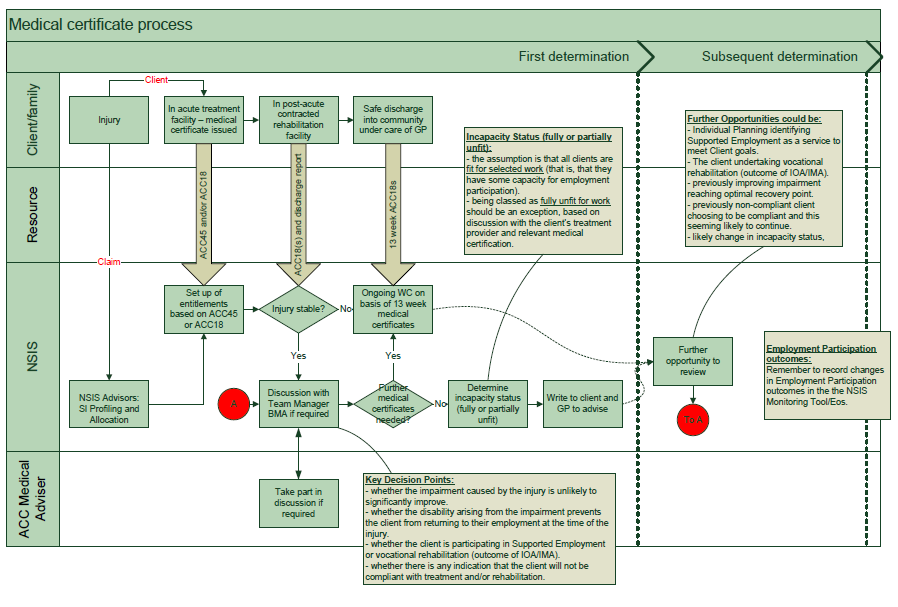
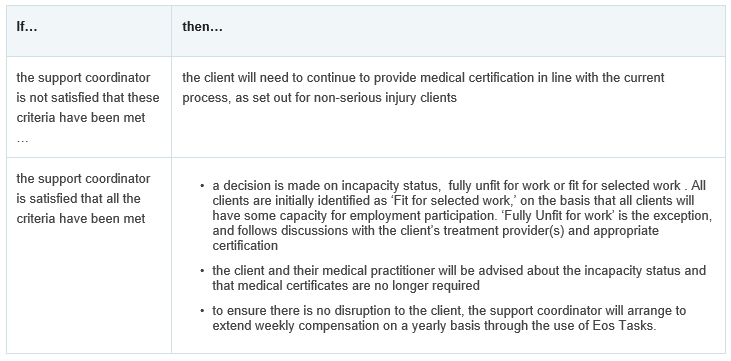
 Medical Certification for Serious Injury Claims v9.0
Summary
2.0 Key Points of the new process
a
Medical Certification for Serious Injury Claims v9.0
Summary
2.0 Key Points of the new process
a An initial decision is made while the client is in post-acute
Objective
rehabilitation, or soon after, about whether ongoing med-
Serious injury claims are managed by the National Serious
ical certificates are required. This decision involves the
Injury Service using a different service approach than for non-
support coordinator consulting with the team manager,
serious injury claims.
and if required an appropriate Medical Adviser, and is
made based on if:
Owner
9(2)(a)
• the disability arising from the impairment has reached a
point from which it is unlikely to significantly improve.
Expert
9(2)(a)
• the client is unable to return to the employment they
Procedure
had at the time of the injury
1.0 Rules
• the client is participating, or planning to participate in a
a In relation to medical certification, serious injury clients
Supported Employment program or vocation rehabil-
differ because:
itation, including the Initial Occupational Assessment/
Initial Medical Assessment process
• they have sustained a significant and permanent impair-
ment
• there is any indication the client will be non-compliant
with necessary treatment requirements, or with the Indi-
• once their condition is stable, a one time determination
vidual Planning process.
can usually be made on their ability to return to their pre-
injury employment
• they will usually have a long term treatment relationship
with one or more medical practitioners.
The process chart below sets out the overall process for
Serious Injury clients.
Key Points of the new process.PNG
b A further decision can be made at a later date, if required
by:
• the IP process identifying Supported Employment as a
service to meet client goals
• the client undertaking vocational rehabilitation, including
the Initial Occupational Assessment/Initial Medical
Assessment process
• the client’s condition or level of compliance changing
Medical Certification for Serious Injury claims
process chart.png
• identification that the status of their inability to work is
likely to, or needs to, be altered.
This process complies with the legislation and removes
the unnecessary burdens of the process for non-serious
injury clients for this group. It removes the financial
burden to clients, of attending a doctor just for an ACC
medical certificate and allows ACC to withdraw from their
lives, thereby enhancing any ongoing relationship with
ACC. The process also reduces the administrative
burden for NSIS staff.
Issues around Fraud and return to work expectations will
be managed outside of the medical certification process.
ACC > Claims Management > Manage Client Payments > Operational Policies > Weekly Compensation > Incapacity > Medical Certification for Serious Injury Claims
Uncontrolled Copy Only : Version 9.0 : Last Edited Thursday, November 21, 2019 9:14 AM : Printed Monday, October 5, 2020 8:22 AM
Page 1 of 1
 Rules for Medical Certificates for Inability to Work v7.0
Summary
2.0 Legislation related to the activities of health
practitioners and the certification ACC will
Objective
accept from health practitioners
Rules for Medical Certificates for Inability to Work v7.0
Summary
2.0 Legislation related to the activities of health
practitioners and the certification ACC will
Objective
accept from health practitioners
This guidance outlines the information that ACC require from
a Legislative changes mean suitably qualified health practi-
a medical health professional when they issue an acceptable
tioners will be able to carry out some activities that could
medical certificate confirming the client is unable to work. This
previously only be done by medical practitioners (doc-
guidance covers retrospective, and forward-dated medical
tors). Refer to the Health Practitioners (Replacement of
certificates. Refer to this guidance to determine whether a med-
Statutory References to Medical Practitioners) Bill in
ical certificate contains the information we require to confirm
Activity 6.0.
inability to work.
b One of these involves a change to the Holidays Act 2003.
1) Rules: medical practitioners issuing medical certificates for
The Holidays Act allows an employer to require an em-
inability to work
ployee to produce proof of sickness or injury. The Act pre-
2) Legislation related to the activities of health practitioners and
viously stated that this proof may include ‘a certificate
the certification ACC will accept from health practitioners
from a medical practitioner’. The recent amendment
3) Acceptance of certificates
changes this to ‘a certificate from a health practitioner’.
4) Retrospective medical certificates
c ACC’s legislation has not changed and the requirement
5) Forward-dated medical certificates
for an assessment of inability to work remains by a med-
6) Links to guidelines and legislation
ical or nurse practitioner.
Owner
d However, ACC can accept a health practitioner’s certif-
9(2)(a)
icate for the purposes of determining the first date the
Expert
9(2)(a)
client became unable to work, if they had taken time off
work to be treated by the health practitioner. ACC would
Procedure
also require confirmation that the client was absent from
work to attend that treatment. The treatment would have
1.0 Rules: medical practitioners issuing medical
to be one that ACC is liable to provide and is necessary
certificates for inability to work
for the client’s covered injury.
a A medical practitioner (or nurse practitioner) can confirm
whether a client is unable to perform their employment
duties through issuing a medical certificate. A medical
3.0 Acceptance of certificates
certificate can be any of the following:
a Certificates that result in the granting of support may be
• an ACC045 ACC injury claim form
accepted by fax or direct from a provider electronically.
• an ACC018 Medical Certificate
• electronically created medical certificate
b All medical certificates must be signed by the relevant
• inability to work included within a report from a medical
provider, or, in the case of an eACC18, must be appro-
practitioner.
priately authorised by the provider. The patient does not
need to sign either the ACC18 or eACC18.
b The medical certificate should be provided by the medical
practitioner the client consulted about the injury when
c When we receive a manual ACC18 Medical Certificate it
they became unable to work.
must have a valid provider ID to ensure that the certif-
icate can be approved for payment.
c For ACC to accept the certificate, it must refer to the
injury in question and clearly identify the client’s restric-
d Provider detail is a mandatory field in Eos, as they must
tions due to the injury.
exist to process a manual ACC18 and/or eACC18. How-
ever, Vendor and Facility fields are optional.
d Electronically created medical certificates can only be ac-
cepted from medical practitioners who have had their
e If the Provider ID is showing as invalid, then you will need
certificates approved by Corporate Office and numbers
to search for the correct Provider or use the dummy
allocated.
number K95229.
e If that doctor is not available, a medical practitioner from
the same practice can provide the certificate, if details of
4.0 Retrospective medical certificates
the consultation can be confirmed.
a Medical certificates that cover a period before the date of
f If a public hospital provided treatment to the client but did
consultation are less convincing proof of inability to work
not complete a certificate, it can be completed later, pro-
and may not be acceptable. In this case:
vided the medical practitioner completing the certificate
has the hospital notes. If required, contact this medical
• obtain further medical information before deciding
practitioner to check that the hospital notes were avail-
whether to accept a retrospective certificate
able to them.
g See the Medical Council of New Zealand's guidelines on
• determine the basis on which the retrospective medical
medical certification for more information on doctors'
certificate has been given. This can be sought from the
professional obligations when completing certificates.
medical practitioner
• obtain confirmation from the client’s employer that they
had time off work due to their inability to work due to the
injury.
b It may also be helpful to get comments from a Medical
Advisor before deciding.
ACC > Claims Management > Manage Client Payments > Operational Policies > Weekly Compensation > Incapacity > Rules for Medical Certificates for Inability to Work
Uncontrolled Copy Only : Version 7.0 : Last Edited Thursday, August 1, 2019 12:31 PM : Printed Monday, October 5, 2020 8:25 AM
Page 1 of 2
c Retrospective certificates by a medical practitioner may
be more compelling when read alongside a Health Practi-
tioner’s certificate particularly where the client has been
treated by them in the intervening period.
5.0 Forward-dated medical certificates
a Medical certificates specifying a period of inability to
work, that starts sometime after the date of consultation,
can be accepted depending on the circumstances of
each case. Factors to be considered in deciding whether
to accept a forward-dated medical certificate include:
• the reason for the certificate being forward-dated, e.g. if
surgery is expected, or a current certificate of inability to
work is due to expire
• gap between the date the certificate was completed and
the specified start date for the period that the client was
unable to work (this must only be a few days)
• the duration of inability to work is specified, particularly
where the certificate is forward-dated because surgery is
planned
• the medical details of the injury and inability to work, i.e.
if the available facts clearly support that the person would
be unable to work
• the basis on which the forward-dated medical certificate
has been given should be determined. This may be
sought from the medical practitioner.
b It may also be helpful to get comments from a Medical
Advisor before deciding.
c Where ACC does accept a forward-dated medical certif-
icate, the period of inability to work is taken from the ‘date
specified on the certificate’, not the date the certificate is
completed.
d Ensure the reasons for accepting or rejecting a forward-
dated medical certificate are recorded on Eos Contacts
Log.
6.0 Links to guidelines and legislation
Medical Council of New Zealand's guidelines on
medical certification
https://www.google.com/url?
sa=t&rct=j&q=&esrc=s&source=web&cd=1&cad=rja
&uact=8&ved=2ahUKEwj23PG9vN_gAhWDV30KH
Qe8AL4QFjAAegQIChAC&url=https%3A%2F%
2Fwww.mcnz.org.nz%2Fassets%2FNews-and-
Publications%2FStatements%2FMedical-
certification.pdf&usg=AOvVaw3KjCXxcxD8x1Y5Ma5
55auc
Health Practitioners (Replacement of Statutory
References to Medical Practitioners) Bill
http://www.legislation.govt.nz/bill/
government/2015/0036/23.0/DLM6514118.html
Holidays Act 2003
http://www.legislation.govt.nz/act/
public/2003/0129/45.0/DLM236387.html
ACC > Claims Management > Manage Client Payments > Operational Policies > Weekly Compensation > Incapacity > Rules for Medical Certificates for Inability to Work
Uncontrolled Copy Only : Version 7.0 : Last Edited Thursday, August 1, 2019 12:31 PM : Printed Monday, October 5, 2020 8:25 AM
Page 2 of 2
 Subsequent Inability to Work (Subsequent Incapacity) v9.0
Summary
Objective
Subsequent Inability to Work (Subsequent Incapacity) v9.0
Summary
Objective
Refer to this guidance to determine whether a client has suf-
fered a subsequent inability to work, and the date that subse-
quent inability to work began. This guidance applies to claims
where the client became unable to work from 1 July 2010.
1) Determining subsequent inability to work
2) Date of subsequent incapacity (DOSI)
Owner
9(2)(a)
Expert
9(2)(a)
Policy
1.0 Determining subsequent inability to work
a A subsequent inability to work can occur if a client has:
• had a period when they were unable to work
• ceases to be unable to work
• becomes unable to work for a further period, due to that
same personal injury.
2.0 Date of subsequent incapacity (DOSI)
a The date the client subsequently becomes unable to
work (date of subsequent incapacity ‘DOSI’) is the first
day of a new period that they are no longer able to work
because of their injury. DOSI also includes time off work
for treatment for their injury.
b To be eligible for a weekly earnings calculation in respect
of an employment, the client must either:
• hold that employment at DOSI and have been in
employment at the date of injury; OR
• satisfy the extension of earner status criteria under
clause 43 of Schedule 1 at DOSI. The client does not
need to be in employment at the date of injury under this
criterion.
Refer to Determine if a subsequent incapacity.
Determine if a subsequent incapacity - Reference
http://thesauce/team-spaces/chips/compensation/
weekly-compensation/reference/incapacity-187/
determine-if-a-subsequent-incapacity/index.htm
Extension of Employment status policy
https://go.promapp.com/accnz/Process/
edf99751-2dab-453e-8e58-db46ad9a1be6?
force=False
Eligibility criteria for weekly compensation
https://go.promapp.com/accnz/Process/aa77ed4c-
f8eb-472b-b001-112a97080068?force=False
3.0 Link to process
(NGCM) Conduct Recovery Check-in Conversation
https://go.promapp.com/accnz/
Process/9ec268dc-24a7-4d98-8776-4f3201104d2a#
ACC > Claims Management > Manage Client Payments > Operational Policies > Weekly Compensation > Incapacity > Subsequent Inability to Work (Subsequent Incapacity)
Uncontrolled Copy Only : Version 9.0 : Last Edited Friday, April 17, 2020 1:37 PM : Printed Monday, October 5, 2020 9:28 AM
Page 1 of 1





















